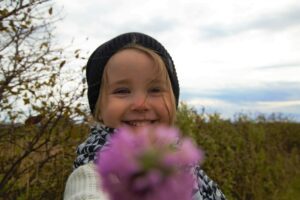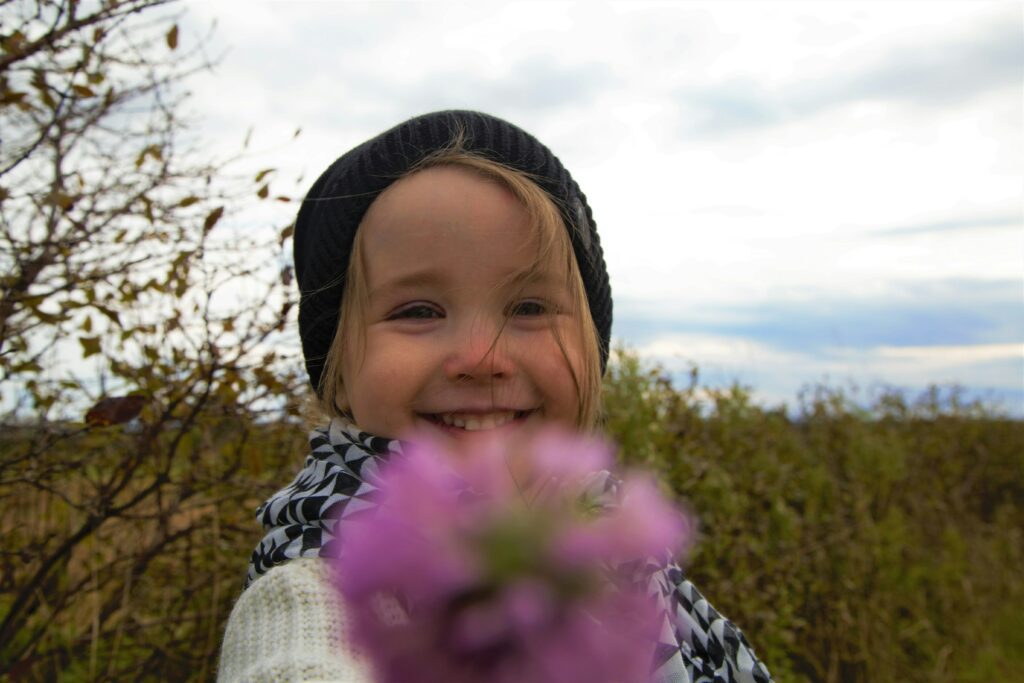September 2024
Vicki Kingsbury, an Early Childhood teacher at Prairie Hill Waldorf School in Wisconsin, shares this timeless article with us for today’s blog!
As a Waldorf Education early childhood teacher, over the years, parents have often asked me: “What one thing can I do to promote my child’s healthy development?” If I had to select one thing, it would be to help your child build the capacity of gratitude. More than any other virtue, gratitude builds resilience, provides children with what is needed to have healthy relationships, and ultimately will help them become responsible citizens and happy human beings. Here’s how…

Children live in our gestures.
We know that young children are “sense organs” that imitate what we say and do. Waldorf teachers often remind parents that our children live in our gestures. In other words, they absorb all we say, and particularly, all we do. This can be both a blessing and a curse. But most of all, it’s a reminder, that we need to be worthy of imitation! Rudolf Steiner, the founder of Waldorf Education states: “…an atmosphere of gratitude should grow naturally in children through merely witnessing the gratitude that their elders feel as they receive what is freely given by their fellow human beings, and in how they express their gratitude.” So first and foremost, we adults can express our gratitude for all that we are given.
What we do at school, you can do at home.
What does this look like at school? As teachers, we try to build the capacity of gratitude throughout the day in almost everything we do, beginning with the verse we speak every morning: “May wisdom shine through me, may love glow in me, may strength penetrate me, that in me might arise, a helper for humanity, a servant of sacred things, selfless and true.” It’s a reminder that we can be vessels to serve each other with love. How do you start your morning? Perhaps you can select a verse to incorporate into your daily rhythm, to help ground you and remind you to be grateful.
When we go on our daily meadow walks, we stop at the chicken coop to thank the chickens for the eggs that they give us to bake our spice cookies, and we say thank you to the honeybees for the honey that we enjoy on our rolls each week. When we eat lunch, we sing a blessing to remind us to be thankful for all that we have been given to eat: “Earth who gives to us this food, sun who makes it ripe and good. Sun above, and earth below, to you are loving thanks we show. Blessings on our meal, on each other, and our school.” When you have breakfast or any meal, do you have a blessing to remind you to be thankful? And if you don’t, perhaps you can create a tradition of just saying thank you, like Meister Eckhart says: “If the only prayer you ever say in your entire life is thank you, it will be enough.”
Appreciation is a holy thing.
At school we practice golden manners throughout the day, which makes us feel grateful, loving, and helps us take responsibility for our interactions. For example, we practice taking turns by asking our friends, “may I have a turn please?” Our friends then answer, “yes, when I am done” (note: we help them say this until it gets into their habit life and comes more naturally). And when our friends hand another their tool or toy, they will say, “thank you.” If this does not happen, we might have them try it again, but this time with kindness. More importantly, we teachers demonstrate gratitude for one another, by practicing our own golden manners; always saying please and thank you, and expressing our authentic appreciation for one another during every interaction or transition. Our golden manners need to come out of an organic place, otherwise they become a bunch of empty manners and the focus is on doing things right, versus doing things compassionately. As Mister Rogers (one of my favorite superheros) once said: “I believe that appreciation is a holy thing.” So every interaction has the potential to be holy. Again, knowing that our children live in our gesture, we strive to be intentional about how we interact, whether or not we express our appreciation, and use language filled with respect, joy, and gratitude. How do you as parents interact with each other? Are you remembering to use your golden manners?! If not, try incorporating more courtesy and appreciation into your repertoire.
Leveraging everyday activities to express appreciation.
Children know they are loved when they are washed, sung to, given a rest, bandaged, have their hair brushed, or back rubbed. Leverage these everyday activities and interactions to express your love and gratitude. Sometimes, in the dailiness of our work, we feel rushed, and may not notice these opportunities; but they can be powerful moments if we remain present. At school, we sing a song as we brush their hair, their arms, legs, and backs as it is so nurturing to receive these sensory-rich experiences. This is a time to connect with your child and show them how much we care and appreciate them. Typically your children are excited to jump into our lap, and they melt when we brush them so intentionally. It’s easy to dismiss these opportunities at home, especially when we might have a lot to do or are feeling overwhelmed. However creating a space for this, is exemplifying gratitude in everyday life. Rudolf Steiner pointed out that a child learns from perceiving meaningful gestures. With these loving gestures, you are modeling what you wish for them. Sometimes it is not what you do, but how you do it. Can you pick an everyday activity that you are already doing, and imbue it with more love and appreciation?
The transformative power of language.
One of the most powerful and transformative practices that I learned when becoming a Waldorf teacher, was about the power of language, and how to reframe words so they are filled with love and positivity. For example, if you see a child throwing a tool, it’s just as easy to say “we take good care of our things” as it is to say “oh no, stop…don’t throw my tools!” But it’s difficult to do and say in the moment. So in our classroom, we have a list of phrases that we utilize after working on reframing things to be more positive. After all, who wants to be the recipient of a string of “No’s” and negative language that shuts you down?
Here are some examples of the phrases we use in our classroom…
- We use our hands for doing good work. (versus hitting, pinching, etc)
- Please use your walking feet. (when they are running inside)
- Ouch my Ears! -or- Please use your inside voice. (for loud voices or yelling)
- Try that again, but this time using your golden manners.
- Say that again, but this time with kindness.
- We take good care of our things (when they are being too rough w/something)
- Please use your listening ears (when they aren’t)
Are there some negative phrases that pop up in your repertoire, that you can transform by saying the inverse or holding them in a light of positivity? Keep in mind, that it helps to hold the “yes” in your heart as you speak to your child, to help the child feel the “yes” that you are gifting them. Using language like this, is just another form of practicing gratitude or expressing our appreciation for one another; because if we can speak to each other respectfully and positively, our interactions will be infused with love instead of conflict and angst.
It’s not happy people who are grateful, it’s grateful people who are happy.

Research shows that we are happier, healthier (less heart disease and stress related disorders) and more resilient when we focus on the positives and not the negatives in life. But how do we do this?
1) We can look at the world through our children’s eyes. Our children more easily see the wonder and positive in the world.
2) We can cultivate our capacity for gratitude by practicing golden manners, appreciating one another, and seeing the potential of each of our interactions as holy.
3) We can look for the goodness (consciously seek it, since we are hardwired to see the negative).
4) We can pay attention to our language and reframe it into a positive light, if it is sounding negative.
Note “(that) our tendency to pay more attention to bad things and overlook good things is likely a result of evolution. Earlier in human history, paying attention to bad, dangerous, and negative threats in the world was literally a matter of life and death. Those who were more attuned to danger and who paid more attention to the bad things around them were more likely to survive.”1 Knowing this, we can actively and purposefully notice and then acknowledge the things that our children do that are positive. In our classroom we share these things at the lunch table, for example, acknowledging when a child has shown another how to swing on a swing, and retrieve the boo-boo buddy when a friend is injured.

In addition to noticing and acknowledging the goodness we see in our children, we want to surround them with goodness (and protect them from the challenges of adulthood until they are ready) to help them feel safe. Because young children are “sense organs” they are like sponges soaking up everything that they are exposed to. They are learning from imitation at this phase; and for this reason, we must be worthy of imitation. We need to remember that it is not what we say or do, but who we are that matters most. And we want to reinforce that the world is good.
“For the child just beginning life, there is one single mantra that needs to guide those early steps and years: the world is good. No other belief will carry him forward through the tumbles and stumbles, through the mysteries of his encounters with confidence and eagerness. Without this overarching rainbow of trust in life around and above them, children shrink back into themselves, lose the shine in their eyes, forgo the impulse to experiment, to see things as the adults around them never have, to imagine new solutions… The world is good – and therefore I enter into it, explore it, wonder, stop and look, touch, encounter, meet what comes to me with interest and growing confidence.”2

To build the capacity for gratitude, we adults must set the example. When children see us expressing appreciation, they will live in this gesture, and it will open the door for the next capacity to awaken—which is the capacity for love. Practicing gratitude will help us become our highest selves. In the ways we foster gratitude, we create a loving environment and teach the children to be loving. More than any other virtue, gratitude builds resilience, provides children with what is needed to have healthy relationships, and helps them become responsible citizens and happy human beings.
- “What Is the Negativity Bias?” By Kendra Cherry, https://www.verywellmind.com/negative-bias-4589618, April 29, 2020.
- “In Difficult Times: How Do I Find and Create Goodness for My Children?” by Susan Weber, http://www.waldorfearlychildhood.org/uploads-new/family_3_2685722600.pdf, March 2011.
Vicki Kingsbury has been a Waldorf early childhood teacher since her own two children started at Prairie Hill Waldorf School in 2003. She has a B.A. in Communication Studies from the University of Massachusetts, graduated from the LifeWays Early Childhood and Human Development program, and from Great Lakes Waldorf Institute. And Vicki wholeheartedly learns more from the children than anything else!
